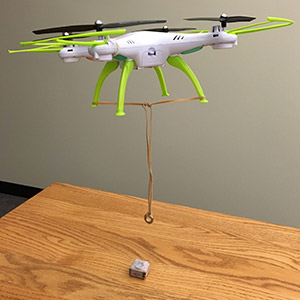UAV Challenge: Deliver Disaster Relief Supplies
Goal
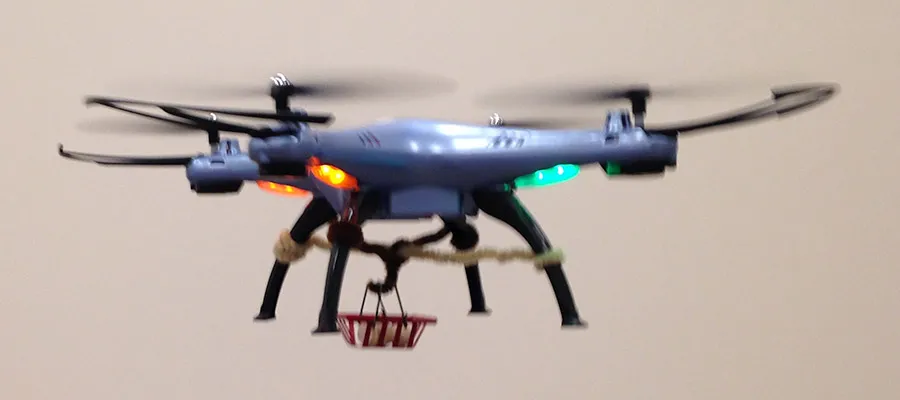
Students use a UAV (Unmanned Aerial Vehicle or "drone") to conduct a simulated disaster relief mission. The baseline mission involves delivery of buckets (representing water) to a landing zone next to a damaged town. Optional extensions incorporate delivery of food or medical supplies to the disaster zone.
One variant of this activity includes a race between teams of students to deliver the most buckets of (simulated) water in a 2-minute span.
Two other activities, UAV Challenge: Aerial Survey of a Disaster Area and Planning a Disaster Relief Mission: Storyboarding, are recommended prerequisites for this activity. This activity can, however, be done without those two prerequisites; you will need to alter some of the discussion sections of this activity and omit some of the “story line” if you choose to do this activity as a standalone.
Unless your students already have substantial UAV flying skills, we strongly recommend that students complete the Learn to Fly! UAV Flight School activities before attempting this payload delivery activity.
Two other activities in our UAV series, UAV Performance Test: Carry a Payload and UAV Challenge: Retrieve a Payload, include elements similar to this payload delivery activity. You might want your students to try one or both of those activities before this one.
Learning Goals
Students utilize problem-solving techniques and the engineering design process to implement an engineering solution to a specified problem.
Learning Objectives
Students learn how to design, build, test, and improve an engineering system “skyhook” to deliver objects to a UAV landing zone adjacent to a mock disaster site.
Time
- Preparation time: 30 minutes to prepare materials and review the activity (i.e., making a skyhook and testing the different miniature objects).
- Class time: 60 minutes, including 30 minutes for optional extensions and assessment questions.
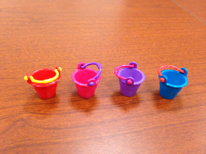
Buckets Representing Water as a Payload
Materials
Place students in groups of approximately 4 to 6, then supply each group with the following:
- Safety glasses, one pair per student
- One UAV ("drone") and the controller used to fly it
- Note:we used the SYMA X5HW-I. Some of the instructions and images are specific to this particular model, but most aspects of this activity can be done equally well with other UAV models
- One to three pipe cleaners for making a simple skyhook
- Stopwatch
- Four to six miniature buckets to simulate water to be delivered to a target UAV landing zone
- One Hula Hoop or similar circular object per group to signify the target UAV landing zone
- Optional: Videos, images, and recording sheets from the Aerial Survey of a Disaster Area activity
Preparation
- Secure a large inside area such as a gymnasium in which to conduct the activity. Minimally, an area 20x30 feet with a ceiling height of 15 feet is recommended.
- Conduct a few test flights delivering miniature buckets to a safe UAV landing zone identified by a Hula Hoop to determine the activity’s ease or difficulty for students.
- Charge batteries for the UAV, including spares.
- Set up the space for the activity as follows:
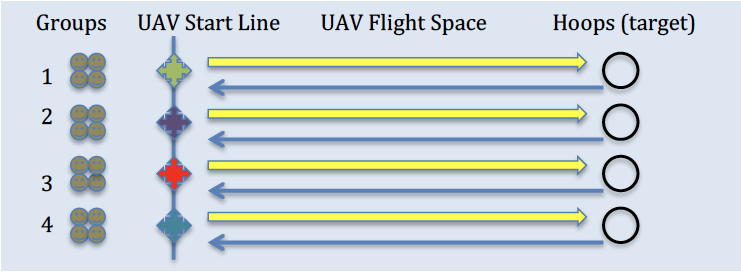
Figure 1. Illustration of the setup needed per group for delivering water to and from a disaster relief zone (target).
Directions
Explain the Challenge
- If students have conducted the Aerial Survey of a Disaster Area activity, ask students to review what they saw. (Students may use their video or photos from that activity to refresh their memories.) Accept all reasonable answers.
- Ask students to describe the types of disaster-relief missions that are often associated with towns that have been destroyed by severe weather. If students conducted the Planning a Disaster Relief Mission: Storyboarding activity, they may say delivering water, food, or medical supplies, or airlifting people from danger.
- If the Planning a Disaster Relief Mission: Storyboarding activity was carried out, ask them to briefly describe their designs for
- Delivering water (i.e., a spigot or siphon for a water container
- Rescuing injured people (i.e., a gurney to lift injured people)
- Delivering medical supplies (i.e., a container to deliver medical supplies)
- Explain that for today’s activity, they will design a simple skyhook using pipe cleaners to deliver miniature water buckets to a safe landing-zone target near the disaster site. The goal will be to safely deliver a set number of buckets, one at a time, to the target area within a specified period of time. This will vary depending upon each class’ materials and the size of the activity area. Note that the water buckets are empty; they represent deliveries of water. Actually using water would make a big mess!
- Demonstrate a simple skyhook design to carry a bucket by UAV to be released at the safe UAV landing zone.
- Encourage students to experiment with different lengths and hook shapes to determine optimal size and shape for accomplishing the skyhook design.
- After a specified number of trial runs (two to four are recommended), groups can change their skyhook design to reduce their time on task completion and/or improve the accuracy of delivery.
- Discuss the importance of how long the skyhook should be (distance from UAV to floor) in order to lift the bucket at the start and release the bucket at the target.
- If students had conducted the Retrieve a Payload or Aerial Survey of a Disaster Area activity previously, ask students to recall the importance of centering the skyhook or camera on the UAV. Ask students to describe what might happen if the payload or camera is off-center.
- After roles are assigned (i.e., Range Safety Officer, Pilot, Spotter, and Timer), have students obtain materials to build the skyhook. Encourage each group to conduct simple trials to ensure that the skyhook can release the bucket easily before actual deliveries begin. Also encourage students to iterate during the test phase and think about the engineering design process.
- Roles may be rotated to see if each group can improve their best time for delivering a bucket successfully to the safe UAV landing zone.
SAFETY NOTE: Explain that each time the UAV returns, the Pilot should power down the UAV before the Payload Engineer attaches the next bucket.
Assign Roles to Team Members
There are several possible roles for students in this activity. Some are essential; others are optional. In some cases, one student might be able to fill more than one role, or more than one student can fill roles with larger groups. In both situations, the team approach should provide opportunities for evaluation of group processes, oral communication, leadership, and collaboration.
- The Pilot uses the hand-held controller to fly the UAV, power up the UAV's propellers in preparation for flight, and power down the propellers after the UAV lands. The Pilot listens to instructions from other team members about navigating the UAV to most efficiently and safely deliver the water buckets to the disaster-site target. This activity requires good piloting skills to maneuver the UAV to the target and gently touch ground to release the bucket.
- The Payload Engineer makes a simple skyhook that can carry a bucket and be suspended from the UAV. She loads the bucket onto the skyhook during each relief mission.
- The Spotter can help the Pilot by concentrating on keeping the UAV away from obstacles and alerting the Pilot to immediate dangers. This support can allow the Pilot to focus on the mission of delivering water to the specified target area near the disaster site. The Spotter can communicate to the Pilot when emergency evasive actions are necessary. The Spotter and Pilot should arrange clear signals that they agree upon before each flight.
- The Spotter also needs to be near enough to the Pilot to communicate with her. If the Spotter faces the same direction as the Pilot, some commands are simpler in terms of communicating direction.
- A Timer can keep track of the flight duration and alert the rest of the team about the passing of time during the mission. The goal will be to deliver each of the payloads in the shortest time possible. The Timer can alert the group that they should fly their UAV back to home base when the expected battery duration is almost reached.
- The Range Safety Officer (RSO) has three responsibilities; explain these to the students.
- To make sure all students involved with the flight wear safety goggles.
- To verify that the launch area and airspace are clear before the flight and signal to the Pilot "all clear" when ready.
- To alert the Pilot if any safety hazards arise during the flight.
- If a safety issue occurs, the RSO should instruct the Pilot to land the UAV and stop the propellers.
- Before flying, the team should discuss where each member will stand during the flight.
Reflection and Assessment
There are several times during this activity when you can assess student performance by asking and reviewing the following questions:
- Has the skyhook been mounted so that it is balanced and can carry the payload? Is the mounting safe, unlikely to interfere with the propellers, and unlikely to fall off during flight? Have the students utilized scientific knowledge and practices to improve their success (e.g., measurements to determine the center of gravity)?
- Do the Pilot, Spotter and Payload Engineer have an effective plan to communicate with each other during their flight and payload delivery? Do they effectively implement their communication plans to ensure optimum performance during each flight?
- Do students deliver buckets to the target by working cooperatively as a team?
- Do students practice and value safety, or do they crash often due to a lack of teamwork and/or adequate preparations?
- Are the students able to improve their skyhook design and/or their delivery times in multiple trials? Do they follow the engineering design process? Are their improvements well thought out, communicated thoroughly, and/or creative?
- Do students embrace their failures as opportunities for further learning?
- At the conclusion, ask students the importance of teamwork, communication, preparation, scientific knowledge, and the engineering design process to accomplishing their tasks. Was failure seen as an opportunity to learn or an end in itself? Do students encourage and support their fellow team members? What else contributed to team learning and/or success?
Safety
- Avoid wind (we recommend flying in a large indoor open space such as a school cafeteria or gymnasium).
- Before flying indoors, check the space you plan to use for safety. Are there any light fixtures,A/V equipment, or other sensitive objects suspended from the ceiling that could be damaged if the UAV collided with them? Are there any fire sprinkler heads that might be set off if disturbed by the UAV, flooding the room? Carefully inspect the space for hazards and fragile objects that could be damaged by the UAV. A gymnasium can be a good choice for indoor flying since the fixtures in a gym are generally designed to withstand being hit by objects heavier than a small UAV, such as basketballs.
- Before each flight, check to make sure the student Pilot knows how to quickly land the UAV and how to quickly stop the UAV's propellers. In the event of a crash, sometimes the propellers will continue to spin (if the UAV is leaning against a wall or is upside down) until the Pilot turns off the propellers. In the case of the SYMA UAV model we used while developing this activity, the Pilot must pull the left joystick towards herself and hold it for a couple of seconds until the UAV propellers stop. Check the instructions for your UAV to make sure you know your model works. Students can become a bit flustered when a UAV crashes, so it is a good idea to review this "emergency" shut down procedure immediately before each flight.
- Whenever a student who is inexperienced at Piloting is controlling the UAV, it is important for the teacher to be near the Pilot and offer assistance as necessary during the flight. In the event of an unsafe situation, help the student in need or take control from the Pilot to ensure that everyone is safe.
- Practice at low altitudes.
- Set and observe flights in safe places with boundaries clear of hazards.
- Be alert. Don't let enthusiasm overcome common sense.
- If there is a potential danger, stop and change the situation.
Extensions
Point system: Award 50 points for each bucket that is delivered to the target within two minutes. If the mission is completed in less than two minutes, add one point for each second less than two minutes. Set up a simple recording table as follows:
| Trial | Number of Buckets Delivered to Target |
Time | Points (Optional) |
|---|---|---|---|
| 1 | |||
| 2 |
- Race: After teams have tested their skyhooks to deliver water to the safe UAV landing zone, have them conduct a race. Starting at the same time, see which team can deliver the water to the target the fastest.
- Provide student groups with additional challenges to deliver needed materials to the disaster site as suggested below. Additional materials will be necessary.
| Extension | Image |
|---|---|
| A larger bucket that can carry more water. | 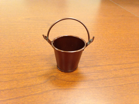 |
| Emergency medical technicians in a basket to treat injured townspeople. | 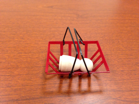 |
| A basket that represents food. | 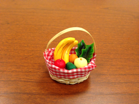 |
| Other: Students construct a stretcher. Craft sticks may be provided or other appropriate materials. | 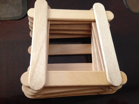 |
Credits
These activities were developed by John Ristvey, Randy Russell, and Teri Eastburn of the UCAR Center for Science Education.
Grade Level
- Upper Elementary
- Middle School
- High School
Educational Standards
Next Generation Science Standards
- DCI: 3-5-ETS1 Engineering Design
- DCI: MS-ETS1 Engineering Design
- DCI: HS-ETS1 Engineering Design
- SEP: Asking Questions and Defining Problems:Define a design problem that can be solved through the development of an object, tool, process, or system and includes multiple criteria* and constraints, including scientific knowledge** that may limit possible solutions. (MS-ETS1-1)
- *criteria – deliver a payload to a target; time required to deliver a payload
- **scientific knowledge -understanding of how mass affects the motion and maneuverability of the UAV; understanding of the pros and cons of different location to place the "skyhook" on the UAV
